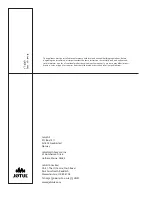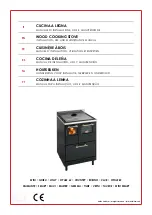
15
138783_Rev_2 1/2/13
When There is No Gas Flow
To The Pilot Head
This is the trouble-shooting procedure for the gas supply:
Check if all gas connections are sealed by using strong
soapy water (avoid synthetic soaps). Be certain all valves
from the gas tank/cylinder are fully open.
When the pilot is to be lit for the first time with a
new installation, after a scheduled disconnection or after
the propane tank has been refilled, there will often be air
in the gas tube leading up to the appliance. The tube sys-
tem must be cleared of air before the pilot burner can be
lit. The recommended method for clearing air out of the
tube system, is to push in the gas control knob and turn
anti-clockwise to “PILOT”. Then push in the gas control
knob for 5 seconds and push the control knob on the spark
igniter to the bottom several times. Repeat the procedure
until the pilot is lit.
If the pilot does not light after attempts to clear the
tube system of air, it indicates a problem with the gas
tank/cylinder or a leak in the gas tube. Check the gas pres-
sure as instructed in the section Gas Installation on page
10 and determine if the fault/leak is before or after the
valve on the appliance. If the gas pressure at outlet D (fig.
20) is too low or there is no gas pressure at all, the fault or
leak must be located before the valve on the appliance. If
the gas pressure is OK at outlet (D), but too low at outlet
(E), then the fault or leak must be located after the valve.
Note! SIT valves are always equipped with a fine filter
at the inlet to avoid dirt from entering into the valve.
Consequently, dirt in the valve is not a common occur-
rence. If gas tubes are dismantled, all gas tubes must be
reinstalled and checked for gas leaks prior to operating
the appliance.
When the Pilot Goes Out - Problems With
the Gas Supply
This is the trouble-shooting procedure for the gas supply:
Remember to push in the gas control knob for at least 30
seconds. Make sure the flame is centred at the thermo-
couple. Make sure the thermocouple is enveloped by the
flame up to at least 3 mm (1/8”) from the tip (fig. 17).
If the flame is abnormally large or small, check the
gas pressure first. See section about gas pressure, page 10.
Then check for errors, dirt or corrosion on the pilot burner
(fig.17), the pilot orifice and the gas supply to the pilot
burner.
Note! There could be a leak after the valve even if the
pressure is OK at outlet E. You should therefore always
check for leakage.
Thermocouple (Fig.23) and Thermopile
(Fig. 24)
A thermocouple is in principle a thermal generator
and consists of a copper wire (copper-nickel alloy) and an
iron wire twisted together. These wires will create friction
and generate 25 millivolt when exposed to a temperature
difference of 200°C. This voltage is sufficient to make the
gas valve function. In order to produce higher voltage a
thermopile is used, which is based on the same principle
as the thermocouple, but with more copper and iron
wires.
The thermopile produces approx. 500-700 millivolts.
This only amounts to 1/3 of the voltage in a flashlight
battery. It is important to understand that even minor
resistance (ohm) will have great impact on such a small
voltage. If resistance is too great, the gas valve may not
receive enough voltage to operate. If there is too much re-
sistance, the cause may be that the copper wire conduct-
ing the voltage is too long, or there are too many con-
nections. If the copper wire comes in contact with metal,
it may increase resistance and consequently reduce the
voltage.
When the Pilot Goes Out, But the Gas
Supply is OK.
This is the trouble-shooting procedure for the thermo-
couple, fig. 23,B: Check the copper wire (F) of the thermo-
couple for cracks or damage.
Check the gasket (C) at the valve by loosening the nut
that holds the copper wire. Look for signs of damage, if
the nut has been tightened too hard. A damaged gasket
results in resistance at contact with metal and conse-
quently the voltage to the valve will be too small.
Make sure the flame is centred at the thermocouple.
Make sure the thermocouple is enveloped by the flame
up to at least 3 mm from the tip (see fig.17). Check the
voltage generated by the thermocouple. Connect the
multimeter (fig.23-E) with plus to the ball point (D) at the
end of the copper wire. Connect minus to the copper wire.
Light the pilot (A) and hold in the control knob to prevent
the flame on the pilot burner from going out. At this
point the multimeter should show 14-28 mV. the ther-
mocouple. Note that there are 2 threaded holes that can
be used when installing a new thermocouple. Make sure
the blue wire (A) is fastened at the same threaded hole.
The nut on the thermocouple must not be tightened too
much, just a 1/2 turn. If the gas pressure is correct and the
possible faults above have been checked, the pilot flame
can be adjusted with the adjusting screw. The gas volume
is increased when the screw is turned anti-clockwise.






































